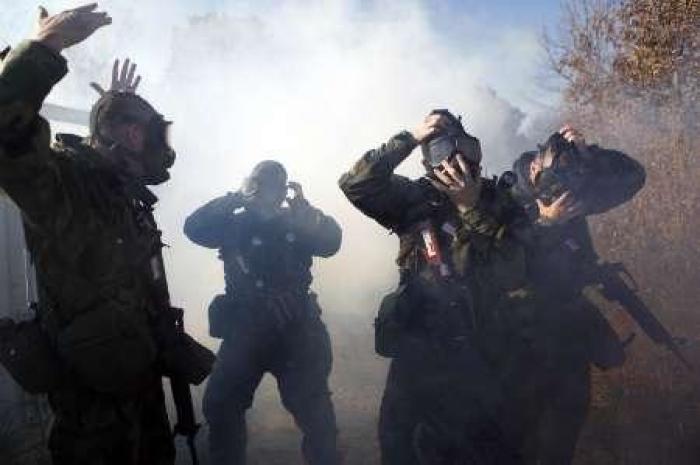Report: ISIS Likely Using Saddam Hussein's Chemical Weapons

Pictures acquired by the Middle East Review of International Affairs provides visual evidence that the Islamic State terrorist group may have already used Saddam Hussein's leftover chemical weapons on Kurdish fighters.
The pictures were published in a report by the Global Research in International Affairs (GLORIA) on Sunday and includes about 20 photographs of mutilated bodies of Kurdish fighters of the Kurdish People's Protection Unit (YPG) that could be a result of ISIS's use of chemical weapons in battle that took place on July 12 in the eastern part of the Kobane enclave.
The report was published two days prior to a New York Times report published Tuesday in which interviewees and an intelligence document show that United States and Iraqi troops encountered over 5,000 chemical warheads, aviation bombs and shells in Iraq from 2004 to 2011. The weapons are believed to be left behind from the rule of Saddam Hussein.
The health minister of the Kurdish authority in Kobane, Nisan Ahmed, suggests that the scars and mutilations shown on the bodies of Kurdish victims from the July 12 attack clearly suggest ISIS's use of chemical weapons.
"Burns and white spots on the bodies of the dead indicated the use of chemicals, which led to death without any visible wounds or external bleeding," Ahmed said.
The New York Times and the GLORIA reports both mention a letter that was sent to the United Nations this summer that claims that over 2,500 corroded chemical weapons containing the nerve-agent Sarin remained at the ruins of the Muthanna State Establishment, which is now controlled by ISIS, also known as ISIL or the Islamic State. The establishment was the center for Iraqi chemical agents during the 1980s, The Times pointed out.
The GLORIA report points out that Iraq's ambassador Mohammed Ali Al-Hakim said after ISIS captured the compound that bunkers 13 and 41 within the compound were of great concern. A United Nations report claims that within bunker 41 alone there were "2,000 empty 155mm artillery shells contaminated with the chemical warfare agent mustard, 605 one-tonne mustard containers with residues, and heavily contaminated construction material."
Although the U.S. government claims that weapons no longer pose a threat since they are rusted and corroded, on six occasions in which United States and Iraqi troops uncovered abandoned chemical weapons, they were wounded while doing so.
Even though The New York Times' interviewees said that weapons they had found were all manufactured before 1991, the fact that troops were injured during the uncovering of the weapons shows that the chemical agents still present a threat.
The Times reported that the U.S. government had known of the discoveries of chemical weapons in Iraq, and the fact that they are harming U.S. troops, since 2003. The New York Times also claimed the government had kept the findings hidden.
Former Army sergeant Jarrod Taylor told the Times that the public was misled for a decade.
"I love it when I hear, 'Oh there weren't any chemical weapons in Iraq,' " Taylor said. "There were plenty."
Retired Army Major Jarrod Lampier told The New York Times that after taking part in the largest chemical weapons discovery in Iraq, where 2,400 nerve-agent rockets were found in 2006, he and the other troops were ordered not to talk about the discovery.
"Nothing of significance is what I was ordered to say," Lampier said.
The Times also quoted an unnamed Army sergeant who suffered from mustard gas exposure saying that he and others were told not reveal their injuries that occurred in dealing with the chemical weapons and it prevented them from seeking medical help.
"I felt more like a guinea pig than a wounded soldier," the former army sergeant said.
Conservatives have taken to Twitter to voice their opinion of the New York Times findings. Many of them, and other supporters of the Iraq War, are taking the reporting as vindication of their positions on the war. Since President George W. Bush originally decided to invade Iraq because intelligence told him Hussein was hiding weapons of mass destruction, liberals and Democrats mocked his presidency, arguing that he misled the public about the existence of WMD's.
One tweet from National Republican Senatorial Committee strategist Brad Dayspring in response to a tweet from MSNBC reporter Benjy Sarlin states: "@BenjySarlin Can we also agree that those who mocked any statement that there were WMD's in Iraq in '03 & '04 were/are wrong?"





























